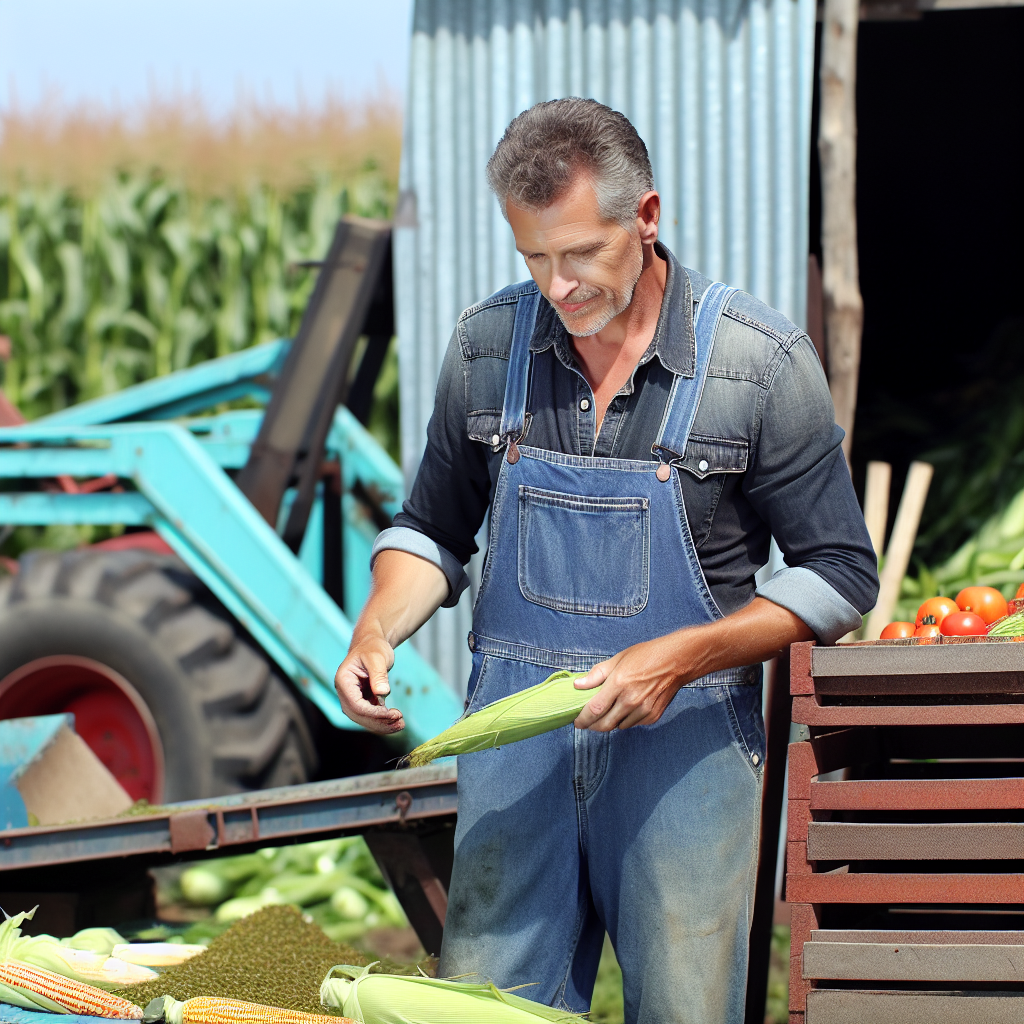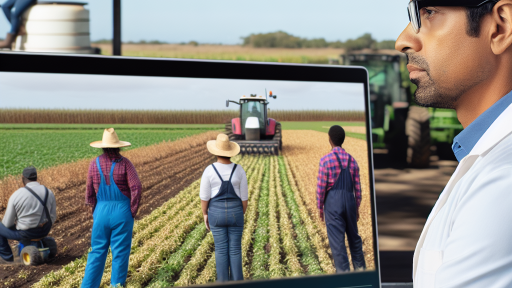Understanding Post-Harvest Losses: Causes and Consequences
Definition of Post-Harvest Losses
Post-harvest losses refer to the reduction in quantity and quality of agricultural products after harvest.
These losses can occur during various stages of the supply chain.
Factors include handling, storage, and transportation methods.
Common Causes of Post-Harvest Losses
Several factors contribute significantly to post-harvest losses.
- Poor handling practices can lead to physical damages.
- Inadequate storage facilities often result in spoilage.
- Inconsistent temperature control increases deterioration rates.
- Pests and diseases can devastate stored products.
- Insufficient market access may force farmers to sell quickly at lower prices.
Consequences of Post-Harvest Losses
Post-harvest losses have far-reaching consequences for farmers and consumers.
- Farmers suffer financial losses due to reduced sales.
- Food insecurity increases as less food is available for consumption.
- Environmental impacts arise from wasted resources and unsold food.
- Economic growth is hindered in communities reliant on agriculture.
Importance of Addressing Post-Harvest Losses
Addressing post-harvest losses is crucial for agricultural sustainability.
Improving practices can enhance food security and farmer profitability.
Moreover, it can contribute to better resource management.
Ultimately, reducing these losses supports local economies and communities.
Common Types of Post-Harvest Losses in Agriculture
Physical Losses
Physical losses occur during handling and transport.
Unintentional damage can happen when crops are moved.
For instance, bruising and crushing significantly affect quality.
Moreover, improper storage can lead to wastage.
Losses Due to Pests and Diseases
Pests and diseases inflict serious damage on stored produce.
Insects and rodents often invade storage facilities.
Transform Your Agribusiness
Unlock your farm's potential with expert advice tailored to your needs. Get actionable steps that drive real results.
Get StartedFungal infections can also destroy a significant portion of crops.
Continued monitoring and prevention are essential.
Quality Degradation
Quality degradation affects market value and sales.
Crops can lose freshness during storage and transport.
Discoloration and spoilage lead to lower prices.
Furthermore, consumers prefer high-quality produce.
Economic Losses
Economic losses arise from decreased income opportunities.
Farmers can face reduced profits due to wastage.
Expenses related to disposal of spoiled goods add up.
Consequently, proper management is crucial for profitability.
Environmental Impact
Post-harvest losses also have environmental consequences.
Wasted food contributes to greenhouse gas emissions.
Decomposing organic matter leads to soil and air pollution.
Addressing these losses can help protect the environment.
Innovative Storage Solutions to Reduce Losses
Introduction to Storage Innovations
Farmers face significant challenges with post-harvest losses.
These losses can drastically affect their income and food security.
Implementing innovative storage solutions can mitigate these issues.
Types of Storage Solutions
Several effective storage solutions exist today.
Technology plays a crucial role in enhancing storage methods.
- Modified Atmosphere Storage maintains optimal conditions.
- Cold storage systems prolong shelf life effectively.
- Biodegradable storage bags reduce environmental impact.
Farmers can choose storage solutions based on their specific needs.
Benefits of Enhanced Storage Techniques
These innovative techniques offer multiple benefits.
First, they significantly reduce spoilage rates.
Moreover, they improve the quality and safety of stored produce.
Additionally, farmers can sell their products at better prices.
Showcase Your Farming Business
Publish your professional farming services profile on our blog for a one-time fee of $200 and reach a dedicated audience of farmers and agribusiness owners.
Publish Your ProfileCase Studies of Successful Implementations
Many farmers have seen success with new storage solutions.
For example, Maria Lopez adopted cold storage technology.
As a result, she minimized losses and increased her revenue.
Similarly, Ahmed Khan used modified atmosphere storage.
He noted improved quality of his vegetables over time.
Challenges and Considerations
Despite the advantages, challenges remain.
Initial costs can deter farmers from investing in solutions.
Training is essential for effective implementation.
Farmers must understand the technology and maintenance requirements.
Future Directions for Storage Solutions
The future looks promising for storage innovations.
Emerging technologies will continue to improve efficiency.
Collaboration with agricultural experts can enhance knowledge sharing.
Ultimately, reducing post-harvest losses is crucial for food security.
Discover More: Economic Advantages of Efficient Post-Harvest Practices
Best Practices for Harvesting to Minimize Damage
Timing of Harvest
Choosing the right time for harvest greatly impacts crop quality.
Observe your crops closely to determine the optimal moment.
Harvest during dry conditions to reduce the risk of disease.
Moreover, pick crops in the cooler parts of the day to minimize stress.
Proper Tools and Techniques
Using the right tools is essential for reducing damage during harvest.
Sharpened knives and sickles ensure clean cuts and minimize injury to plants.
Invest in equipment tailored to the specific crops you grow.
Utilizing baskets or containers can help in transporting harvested crops gently.
Avoiding Overripe or Underripe Crops
Harvesting at the correct ripeness level enhances marketability.
Overripe crops are prone to bruising and spoilage.
On the other hand, underripe crops may not satisfy market demands.
Regularly assess your crops as the harvest approaches.
Post-Harvest Handling Practices
Effective post-harvest handling significantly reduces losses.
Clean and sort harvested crops immediately to ensure quality.
Store crops in suitable conditions to preserve freshness.
Maintain optimal temperature and humidity levels during storage.
Educating Workers
Training your workforce is vital in implementing best practices.
Conduct regular training sessions on proper harvesting techniques.
Ensure all workers understand the importance of careful handling.
Encourage open communication about potential issues during harvest.
Delve into the Subject: Weed Management Strategies for Organic Farmers
The Role of Technology in Monitoring Crop Quality Post-Harvest
Importance of Post-Harvest Monitoring
Post-harvest monitoring is crucial for maintaining crop quality.
It directly impacts marketability and profitability for farmers.
Advanced technology enhances the precision of these monitoring efforts.
Various Technologies in Use
Farmers employ several technologies to track crop quality.
These include sensors, drones, and data analytics platforms.
Showcase Your Farming Business
Publish your professional farming services profile on our blog for a one-time fee of $200 and reach a dedicated audience of farmers and agribusiness owners.
Publish Your ProfileEach technology offers unique advantages for monitoring conditions.
Sensors for Environmental Monitoring
Sensors measure temperature, humidity, and other critical factors.
They provide real-time data to farmers for informed decision-making.
Consequently, farmers can adjust storage conditions proactively.
Drones for Crop Surveillance
Drones equipped with cameras survey large fields efficiently.
They identify areas of concern like pest infestations quickly.
This allows for targeted interventions that minimize losses.
Data Analytics Platforms
Data analytics platforms help interpret large amounts of information.
Farmers can analyze historical data alongside current conditions.
This facilitates better forecasting and planning for future crops.
Benefits of Technology in Post-Harvest Practices
Utilizing technology in post-harvest practices yields numerous benefits.
First, it reduces waste and enhances shelf life of crops.
Moreover, it also increases overall productivity and efficiency.
Farmers gain a competitive edge in increasingly demanding markets.
Challenges in Adopting Technology
Despite the benefits, several challenges exist for adoption.
Cost and accessibility remain significant barriers for many farmers.
Moreover, there is a need for training to use these technologies effectively.
Partnerships with tech companies can facilitate solutions.
Future of Post-Harvest Monitoring
The future looks promising with rapid advancements in technology.
Innovations like artificial intelligence and machine learning will emerge.
Such developments can further refine monitoring processes.
Ultimately, these changes will lead to more sustainable farming practices.
Find Out More: Enhancing Crop Yield With Disease Forecasting Techniques

Implementing Effective Marketing Strategies to Reduce Waste
Identifying Target Markets
Farmers should begin by identifying their target markets.
Understanding consumer preferences helps tailor marketing strategies.
Additionally, researching local market trends can uncover opportunities.
Farmers can assess demand by actively engaging with consumers.
Gathering feedback allows producers to adjust their offerings accordingly.
Building Strong Relationships with Retailers
Establishing strong relationships with local retailers is essential.
Regular communication builds trust and ensures product visibility.
Farmers can benefit from providing retailers with marketing materials.
Collaborative promotions may increase product turnover and reduce waste.
Moreover, personalizing outreach efforts fosters loyalty from retailers.
Utilizing Digital Marketing Techniques
Digital marketing offers farmers modern ways to reach consumers.
Creating an engaging website showcases products effectively.
Social media platforms can enhance brand presence and engagement.
Email marketing allows direct communication with interested consumers.
Using online marketplaces expands reach beyond local boundaries.
Participating in Local Events and Farmers Markets
Participating in local events is a great opportunity for exposure.
Farmers markets allow direct interaction with consumers.
Showcase Your Farming Business
Publish your professional farming services profile on our blog for a one-time fee of $200 and reach a dedicated audience of farmers and agribusiness owners.
Publish Your ProfileThese venues create a platform to educate consumers about products.
Additionally, samples can entice potential buyers and drive sales.
Networking with other vendors can lead to beneficial collaborations.
Leveraging Community Supported Agriculture (CSA)
Community Supported Agriculture allows for direct consumer engagement.
Consumers invest in a farm at the beginning of the season.
This model provides farmers with upfront capital for production.
Furthermore, it ensures a dedicated customer base throughout the season.
In turn, CSAs help reduce surplus and minimize waste.
Monitoring Market Feedback and Adjusting Strategies
Continuous monitoring of market feedback is vital for success.
Farmers should analyze sales data to identify trends.
Adjusting strategies based on feedback can reduce surplus production.
Moreover, being responsive to consumer preferences enhances loyalty.
Ultimately, adapting marketing efforts leads to sustainable practices.
See Related Content: Aquaponics Benefits for Farmers
Training and Education for Farmers on Post-Harvest Management
The Importance of Training
Training enhances farmers’ knowledge and skills in post-harvest management.
Proper education helps reduce post-harvest losses significantly.
Moreover, it fosters better understanding of storage techniques and their benefits.
Workshops and Seminars
Regular workshops can provide hands-on experience for farmers.
These events allow farmers to learn best practices from experts.
Additionally, seminars can cover new technologies in post-harvest management.
Collaboration with Agricultural Experts
Collaboration is key for effective training programs.
Farmers should partner with agricultural extension services.
Experts can offer tailored training sessions that meet local needs.
Utilizing Technology
Technology plays a vital role in modernizing post-harvest practices.
Mobile applications can provide timely information on best practices.
Online courses can reach more farmers, even in remote areas.
Community Engagement
Engaging the community fosters a learning environment.
Support groups can share knowledge and experiences among farmers.
Peer-to-peer learning can enhance practical understanding of post-harvest techniques.
Evaluation and Feedback
Continuous evaluation of training effectiveness is essential.
Farmers should provide feedback on their learning experiences.
This information can help improve future training initiatives.
Policies and Support Systems for Reducing Post-Harvest Losses
Importance of Strong Policies
Effective policies significantly reduce post-harvest losses.
Governments play a crucial role in establishing these policies.
Supportive legislation encourages investment in the agricultural sector.
Furthermore, clear regulations improve quality standards for harvested products.
Government Initiatives
Governments can initiate programs to enhance farmers’ access to technology.
Subsidies for storage facilities help mitigate losses during the harvest period.
In addition, training programs teach farmers efficient harvesting techniques.
This knowledge prepares them for the post-harvest phase.
Showcase Your Farming Business
Publish your professional farming services profile on our blog for a one-time fee of $200 and reach a dedicated audience of farmers and agribusiness owners.
Publish Your ProfilePublic-Private Partnerships
Collaboration between public and private sectors is vital.
Such partnerships can create innovative solutions for post-harvest losses.
For instance, companies can invest in advanced storage technologies.
These technologies help preserve the quality of crops after harvesting.
Financial Support for Farmers
Access to financial resources empowers farmers to invest in better practices.
Micro-loans can facilitate the purchase of necessary equipment.
Additionally, grants can support research into effective post-harvest methods.
This financial assistance promotes sustainability in farming practices.
Training and Education Programs
Educational programs are essential for improving post-harvest management.
Workshops can provide farmers with vital information about best practices.
Moreover, they can learn about pest management to reduce losses.
Such training encourages continuous growth in agricultural productivity.
Community Support Systems
Community networks offer valuable support during the post-harvest period.
Local cooperatives can share resources and information among farmers.
They can also create collective marketing strategies to reduce waste.
This approach enhances farmers’ bargaining power in the market.
Monitoring and Evaluation
Continuous monitoring of policies is necessary for effectiveness.
Evaluation systems can identify areas needing improvement.
Feedback from farmers helps policymakers refine existing strategies.
A responsive approach ensures ongoing support for reducing losses.
Additional Resources
Food Loss: Why Food Stays On the Farm or Off the … – USDA ERS
Reducing food loss and waste for climate outcomes: Insights from …




